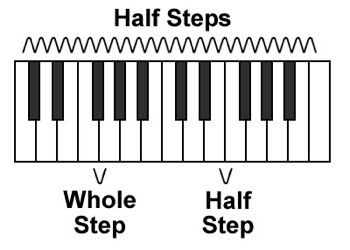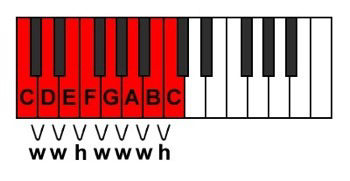
In this part of our discussion, we’ll be leaving the world of chords and progressions to talk about music played one note at a time. Welcome to the world of scales.
Concept - Half Steps and Whole Steps
First, a definition. On a keyboard, the distance from a note to the nearest note on the right or left is called a half step. A distance of two half steps is called a whole step. (On a guitar, each fret represents another half step.)
When counting half steps and whole steps on a keyboard, look at the back edge of the keys, where white notes and black notes are side by side. If you look at the front edge, where only white notes are next to each other, you might make a mistake. (The distance from one white note to the next can be a half step or a whole step. It depends on whether or not a black note is between them.)

Concept - Formula for the Major Scale
Half steps and whole steps allow us to describe a scale as a series of jumps. The major scale follows the formula "whole, whole, half, whole, whole, whole, half" or WWHWWWH.
Beginning on the note C and following this pattern gives us C, D, E, F, G, A, B, C.

Notice that the words "whole" and "half" do not refer to any of the notes. They describe the distances between them. It could be written this way...
C-w-D-w-E-h-F-w-G-w-A-w-B-h-C
Using numbers instead of notes gives us...
1-w-2-w-3-h-4-w-5-w-6-w-7-h-1
Challenge - Learning the Major Scale in 12 Keys
It's a good idea to make it your goal to learn the major scale in all 12 major keys. This will take a while, but it's well worth it. When you have a good understanding of these 12 keys, playing will be more natural, and it will also be easier to talk about chord names.
Secondly, while playing scales up and down is a helpful exercise, it’s also beneficial to play song melodies, one note at a time. This forces you to jump around in the key and land on the correct notes.
So the challenge is really two challenges: one is memorizing the scales, and the other is playing songs using the notes found in those scales.
We’ll Start with C Major
It's true that each of the major scales follows the formula WWHWWWH, and if you need to you can generate them that way, but that isn't how we memorize them. We memorize them as "shapes" or "pictures" or "collections of notes grouped together." For example, the "shape picture" for C major might look like this.

The starting note (Note 1) is C, and the piano keys needed to play this scale are all white notes.
Look at the white circles for a moment. Can you mentally picture the rest of the letter names? Do you "see" C, D, E, F, G, A, B, C? What if we numbered them? Can you see 1, 2, 3, 4, 5, 6, 7, 1? Which key is number 5? The key E is what number? Number 6 is what letter? And finally, if you were asked to play the sequence 5-3-2-1-6-4-5, do you see which notes you would play and in what order?
So when we say the challenge is to learn all 12 major scales, what we mean is...
- first, to be able to picture each scale
- second, to know the letter name of each note in the scale
- third, to know the number of each note in the scale
- fourth, to play sequences of notes when given the numbers
A Moment for Perspective
If this is the first time you've seen this challenge, it may look like a long journey. In some ways, that’s true. But the good news is that if we walk slowly through the material - not rushing, but enjoying the process - and if we spend some time in all the various places, eventually it will become easier. And you will be a better musician for having been on the journey.
Let’s Review
In this section we learned about whole steps and half steps. We also learned that a scale can be described as a series of whole and half steps. When we know the "formula" for the scale, we can choose a starting note and generate the rest of the scale by following the jumps indicated by the formula. (Also, the whole and half steps are not actual notes themselves; they are the distances between the notes.)
The major scale has the formula WWHWWWH. Beginning with C and following the jumps, we get C, D, E, F, G, A, B, C. These notes happen to be white notes, so the C scale picture looks like diagram.

Looking at this picture, we realize we need to know each note as both a letter and a number, and then be able to play number sequences. We hope eventually to be able to play in the key of C major, and also in the other eleven major keys.
When you feel good about the concepts and ideas in this section, move on to Part Seven.
OTHER RESOURCES
PDF eBook
The materials presented in Section 1 (Parts 1-12) are available as a downloadable PDF eBook. Click for more information.
Yours To Play It
...free, interactive, chord-exploring MIDI controller app for
Windows computers.
ChordMapMidi
...interactive, chord-exploring MIDI controller app for iPhone.
ChordMaps2
...interactive, chord-exploring MIDI controller app for iPad.
CarolPlayMidi (Christmas Carols and Hymns), DrumMapMidi (basic
drum patterns), and PowerPlay5 (play power chords on iPhone) are
our other iPad and iPhone MIDI controller apps.
______________________
Music Theory for Songwriters is part of MugglinWorks.com
https://mobirise.com easy creator